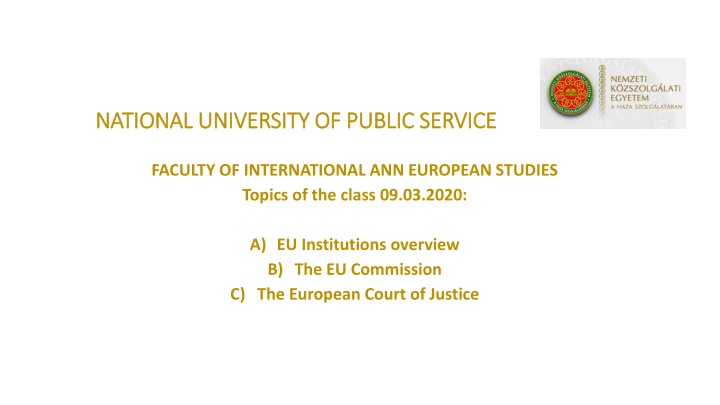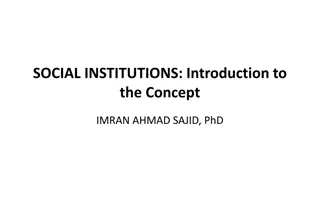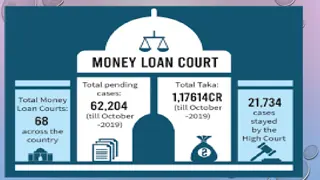The EU: Institutions and History Overview
The European Union, a unique supranational entity blending federal and international aspects, wields significant economic and political influence globally. Delve into the EU's core institutions, focusing on the European Commission and the European Court of Justice. Explore the EU's evolution, from its origins in the European Coal and Steel Community to its current role as a major player in international trade negotiations and governance.
Download Presentation

Please find below an Image/Link to download the presentation.
The content on the website is provided AS IS for your information and personal use only. It may not be sold, licensed, or shared on other websites without obtaining consent from the author.If you encounter any issues during the download, it is possible that the publisher has removed the file from their server.
You are allowed to download the files provided on this website for personal or commercial use, subject to the condition that they are used lawfully. All files are the property of their respective owners.
The content on the website is provided AS IS for your information and personal use only. It may not be sold, licensed, or shared on other websites without obtaining consent from the author.
E N D
Presentation Transcript
NATIONAL NATIONAL UNIVERSITY UNIVERSITY OF OF PUBLIC PUBLIC SERVICE SERVICE FACULTY OF INTERNATIONAL ANN EUROPEAN STUDIES Topics of the class 09.03.2020: A) EU Institutions overview B) The EU Commission C) The European Court of Justice
The EU today Between a federal state and a classic international organization, the EU gathers many of the largest economies worldwide creating with its common market the biggest economy worldwide and the second biggest democracy (EP elections) The EU is in charge for all WTO negotiations on behalf of its members (this is why the trade war of President Trump results in him facing the EU as a tough counterpart). https://www.bbc.com/news/world-europe-47439302
The European Commission currently https://europa.eu/european-union/about-eu/institutions-bodies/european- commission_en
The European Commission - history The first Commission originated in 1951 as the nine-member "High Authority" under President Jean Monnet, which was the supranational administrative executive of the new European Coal and Steel Community (ECSC). It took office first on 10 August 1952 in Luxembourg City. In 1958, the Treaties of Rome had established two new communities (EEC and Euratom). The executive organs of these were called "Commissions" rather than "High Authorities". The reason for the change in name was the new relationship between the executives and the Council. Some states, such as France, expressed reservations over the power of the High Authority, and wished to limit it by giving more power to the Council rather than the new executives.
The European Commission - history The executive organs of these were called "Commissions" rather than "High Authorities". The reason for the change in name was the new relationship between the executives and the Council. Some states, such as France, expressed reservations over the power of the High Authority, and wished to limit it by giving more power to the Council rather than the new executives. The three bodies, collectively named the European Executives, co-existed until 1 July 1967 when, under the Merger Treaty, they were combined into a single administration. The first Commission under its Belgian president Jean Rey completed the Community's customs union in 1968, and campaigned for a more powerful, elected, European Parliament.
Court of Justice of the European Union (CJEU) Role: Ensuring EU law is interpreted and applied the same in every EU country; ensuring countries and EU institutions abide by EU law. Members: Court of Justice: 1 judge/country plus 11 advocates general General Court: 47 judges. In 2019 this will be increased to 56 (2 judges/country) Established in: 1952 Location: Luxembourg Website: https://curia.europa.eu/jcms/jcms/j_6/en/ (CJEU)
Court of Justice of the European Union (CJEU) The Court of Justice of the European Union (CJEU) interprets EU law to make sure it is applied in the same way in all EU countries, and settles legal disputes between national governments and EU institutions. It can also, in certain circumstances, be used by individuals, companies or organisations to take action against an EU institution, if they feel it has somehow infringed their rights.
The CJEU gives rulings on cases brought before it. The most common types of case are: interpreting the law (preliminary rulings) national courts of EU countries are required to ensure EU law is properly applied, but courts in different countries might interpret it differently. If a national court is in doubt about the interpretation or validity of an EU law, it can ask the Court for clarification. The same mechanism can be used to determine whether a national law or practice is compatible with EU law. enforcing the law (infringement proceedings) this type of case is taken against a national government for failing to comply with EU law. Can be started by the European Commission or another EU country. If the country is found to be at fault, it must put things right at once, or risk a second case being brought, which may result in a fine. annulling EU legal acts (actions for annulment) if an EU act is believed to violate EU treaties or fundamental rights, the Court can be asked to annul it by an EU government, the Council of the EU, the European Commission or (in some cases) the European Parliament. Private individuals can also ask the Court to annul an EU act that directly concerns them. ensuring the EU takes action (actions for failure to act) the Parliament, Council and Commission must make certain decisions under certain circumstances. If they don't, EU governments, other EU institutions or (under certain conditions) individuals or companies can complain to the Court. sanctioning EU institutions (actions for damages) any person or company who has had their interests harmed as a result of the action or inaction of the EU or its staff can take action against them through the Court.
How does the CJEU work? In the Court of Justice, each case is assigned 1 judge (the "judge-rapporteur") and 1 advocate general. Cases are processed in 2 stages: Written stage The parties give written statements to the Court - and observations can also be submitted by national authorities, EU institutions and sometimes private individuals. All of this is summarised by the judge-rapporteur and then discussed at the Court's general meeting, which decides: How many judges will deal with the case: 3, 5 or 15 judges (the whole Court), depending on the importance and complexity of the case. Most cases are dealt with by 5 judges, and it is very rare for the whole Court to hear the case. Whether a hearing (oral stage) needs to be held and whether an official opinion from the advocate general is necessary. Oral stage a public hearing Lawyers from both sides can put their case to the judges and advocate general, who can question them. If the Court has decided an Opinion of the advocate general is necessary, this is given some weeks after the hearing. The judges then deliberate and give their verdict. General Court procedure is similar, except that most cases are heard by 3 judges and there are no advocates general.
The CJEU and the citizens a) If you as a private individual or as a company have suffered damage as a result of action or inaction by an EUinstitution or its staff, you can take action against them in the Court, in one of 2 ways: aa) Indirectly through national courts (which may decide to refer the case to the Court of Justice) bb) directly before the General Court if a decision by an EU institution has affected you directly and individually. b) If you feel that the authorities in any country have infringed EU law, you must follow the official complaints procedure.
Most important Rulings of European Court of Justice regarding European Integration 1. Van Gend & Loos (C-26/62, 1963, 1, 25) 2. Costa/E.N.E.L. (C-6/64, 1964, 1251) 3. Francovich (C-6/90 und C-9/90, 1991, 5357) 4. Dassonville ( C 8-47, 174, 837) 5. Cassis de Dijon (C 509/09, 1979, 649)
Thank you for your attention! Thank you for your attention!























